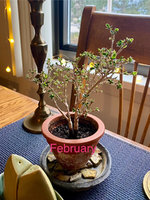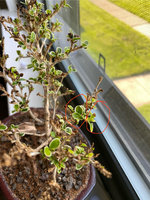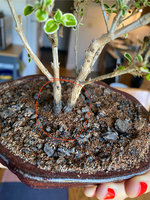I've had this serissa for 3 years indoors. I got it in a 2" pot and put it in Pro-mix potting soil as advised by the nursery owner. I repotted it for the first time in February in a standard bonsai mix. A few days later most of the leaves turned brown and shriveled (not crispy) which I think was caused by putting it back in direct sun after repotting. I kept it out of direct sun for several weeks and there was lots of new growth.
Then I made another mistake by trimming branches without new growth that I thought were dead. Most leaves turned brown again. It's finally starting to grow back green again, but I've noticed tiny brown spots on a couple leaves that seem to be growing until the whole leaf is dead. I also noticed the base of the trunk is black (from when it was in potting soil) but started having white fuzzy mold (?) on it since it's been repotted. The serissa is now on a south facing window sill with air circulation and the spots seem to be mostly gone but the bottom of the truck is still black/white.
I live in upstate NY in an apartment so I cannot put it outside. Please help!!
Then I made another mistake by trimming branches without new growth that I thought were dead. Most leaves turned brown again. It's finally starting to grow back green again, but I've noticed tiny brown spots on a couple leaves that seem to be growing until the whole leaf is dead. I also noticed the base of the trunk is black (from when it was in potting soil) but started having white fuzzy mold (?) on it since it's been repotted. The serissa is now on a south facing window sill with air circulation and the spots seem to be mostly gone but the bottom of the truck is still black/white.
I live in upstate NY in an apartment so I cannot put it outside. Please help!!






